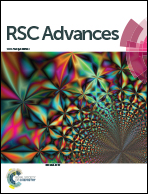Nanogel containing electrospun nanofibers as a platform for stable loading of proteins†
Abstract
We designed polysaccharide nanogel containing gelatin fibers for encapsulation and sustained release of proteins. A solution (phosphate buffer saline/ethanol) containing both acryloyl-group-modified cholesterol-bearing pullulan nanogels and gelatin was electrospun to fabricate the fibers. The fibers were characterized by scanning electron microscopy, transmission electron microscopy, and stimulated emission depletion microscopy. The nanogels were uniformly dispersed in the fibers and gradually released in serum-containing medium. Protein aggregation was observed in the fibers containing only gelatin, whereas proteins encapsulated in nanogels were dispersed without aggregation in the gelatin/nanogel fibers. To investigate the effectiveness of the nanogels as protein stabilizers, horseradish peroxidase (HRP)-containing fibers in the presence and absence of nanogels were prepared and the residual enzyme activities of HRP were measured. Compared with HRP in fibers without nanogels, HRP in nanogel-containing fibers showed higher residual enzyme activity (∼79%) even after electrospinning with ethanol. These results suggest that nanogel-containing fibers have great potential as protein carriers and scaffolds for tissue engineering.


 Please wait while we load your content...
Please wait while we load your content...